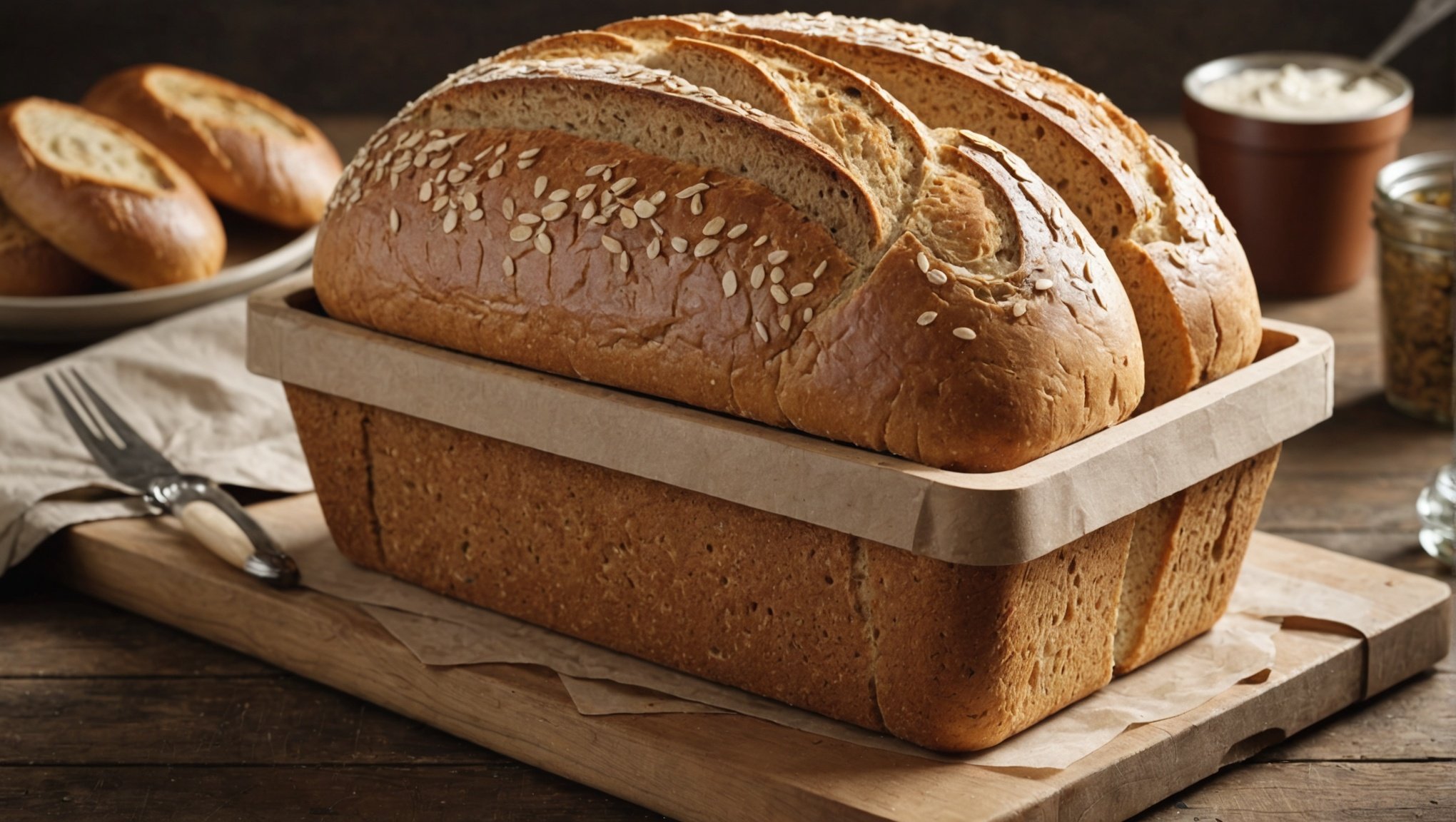Keeping your bread box mold-free is essential for enjoying fresh bread every day. Mold not only spoils your favorite loaf but also poses health risks. With the right strategies, you can maintain an ideal environment for your bread. Discover expert tips that go beyond common advice, ensuring your bread storage remains clean and efficient. Say goodbye to mold and hello to delicious, fresh bread with each slice!
Understanding Mold Growth in Bread Boxes
Mold, a type of fungus, thrives in environments with the right conditions, making bread boxes susceptible to mold growth. Mold prevention is crucial for maintaining the freshness of bread and ensuring hygienic storage. The growth cycle of mold begins when spores land on a surface with adequate moisture, warmth, and nutrients. Bread, being rich in carbohydrates, provides an ideal nutrient source.
Also to read : Transforming Your Kitchen: How a Waste Sorting System Can Inspire Healthier Eating Choices
Several factors contribute to mold growth in bread boxes. Bread storage methods significantly impact mold development. For instance, storing bread in a humid or warm box accelerates mold proliferation. Additionally, if the bread box is not cleaned regularly, residual crumbs and moisture can foster mold growth. It’s essential to control these factors to prevent mold.
Maintaining a mold-free environment in a bread box is vital. This involves ensuring the box is dry and clean, and implementing proper bread storage techniques. For effective mold prevention, consider using airtight containers or materials that reduce moisture exposure. Regularly cleaning the bread box and monitoring the storage conditions can significantly reduce the risk of mold, prolonging the bread’s freshness and safety for consumption.
Also to read : Transforming Your Kitchen: How a Waste Sorting System Can Inspire Healthier Eating Choices
Selecting the Right Bread Box
Choosing the right bread box is essential for effective bread storage and mold prevention. The material of the bread box plays a crucial role in this. Wood, plastic, and metal are common materials, each with distinct properties affecting mold growth.
- Wooden bread boxes offer a natural aesthetic and moderate airflow, which can help in reducing moisture buildup. However, they may require regular maintenance to prevent mold.
- Plastic bread boxes are lightweight and often come with airtight seals, which are effective in keeping moisture out. Yet, they might not be as durable over time.
- Metal bread boxes, such as those made from stainless steel, are sturdy and often have a sleek design. They provide excellent protection against external moisture, making them a good mold-resistant option.
When selecting a bread box, look for features like airtight seals and ventilation systems. These features help maintain the best bread storage conditions by controlling humidity and airflow.
For those seeking reliable brands, consider options like Brabantia, Wesco, and Oggi, known for their durable and mold-resistant designs. By choosing the right material and features, you can significantly enhance your bread storage experience.
Optimal Storage Conditions for Bread
Maintaining bread freshness requires careful attention to storage conditions. The ideal environment balances temperature, humidity, and air circulation. Bread thrives best at room temperature, specifically between 20-22°C. This range prevents staleness and mold growth, ensuring the bread remains soft and palatable.
Humidity levels are equally crucial. Aim for 50-60% humidity to avoid excess moisture, which can lead to mold. Conversely, too little humidity causes bread to dry out. Temperature control is vital; avoid storing bread near heat sources like ovens or direct sunlight, as this accelerates spoilage.
Air circulation within the bread box also plays a significant role in preserving bread longevity. Adequate airflow prevents moisture buildup, a common cause of mold. Ensure your bread box features ventilation holes or a design that allows for some air exchange without exposing the bread to too much air, which can dry it out.
For optimal positioning, place your bread box in a cool, dry spot in the kitchen, away from appliances that emit heat. This strategic placement helps maintain the ideal storage conditions, extending the life of your bread while keeping it fresh and delicious.
Cleaning and Maintenance Tips
Ensuring a clean bread box is crucial for preventing mold and maintaining hygiene. Different materials require specific cleaning approaches. For wooden bread boxes, use a damp cloth with mild soap. Avoid soaking the wood to prevent warping. Plastic bread boxes can be washed with warm, soapy water and a non-abrasive sponge. For metal bread boxes, use a mixture of water and vinegar to remove any potential rust or stains, followed by a thorough drying to avoid moisture buildup.
Regular cleaning is essential. Aim to clean your bread box weekly to prevent mold and crumbs from accumulating. This routine helps maintain a hygienic environment for your bread.
When selecting cleaning products, opt for natural solutions like vinegar or baking soda, which are effective and safe for food storage areas. Avoid harsh chemicals that might leave residues.
Implementing these maintenance strategies not only extends the lifespan of your bread box but also ensures your bread remains fresh and safe to consume. By following these hygiene practices, you create a healthier storage environment, reducing the risk of mold growth significantly.
Best Practices for Bread Storage
Implementing effective bread storage techniques is essential for maintaining freshness and preventing mold. Different types of bread require specific wrapping methods to preserve their quality. For instance, sourdough and artisan breads benefit from being wrapped in a breathable cloth or paper bag, allowing them to retain their crust’s texture while preventing moisture buildup. In contrast, sliced sandwich bread fares better in airtight plastic bags to maintain its softness.
Proper organization within the bread box is crucial for optimal air circulation, which aids in mold prevention. Arrange loaves with space between them to ensure air can flow freely, reducing the chances of moisture accumulation. Avoid stacking bread tightly, as this can trap humidity and accelerate spoilage.
Common mistakes in bread storage often include placing bread near heat sources or in direct sunlight, which can lead to rapid staling. Additionally, storing bread in the refrigerator, contrary to popular belief, is not advisable as it speeds up the staling process. Instead, focus on keeping your bread at room temperature in a well-ventilated bread box. By following these freshness tips, you can enjoy longer-lasting, delicious bread.
The Role of Ingredients in Bread Mold Growth
Understanding the impact of bread ingredients on mold susceptibility is crucial for effective storage. Preservatives, commonly found in store-bought bread, play a significant role in inhibiting mold growth. These additives extend the bread’s shelf life by creating an environment less conducive to mold spores. In contrast, homemade bread, often free from preservatives, is more prone to mold due to its natural ingredients and higher moisture content.
When comparing homemade and store-bought bread, it’s essential to consider the type of flour, sugar, and yeast used. These elements influence how quickly bread can spoil. For those seeking longer-lasting bread, opting for varieties with natural preservatives like vinegar or honey can be beneficial. These ingredients naturally deter mold without compromising flavour.
Baking tips for homemade bread include ensuring thorough kneading and baking to reduce moisture, which is a primary factor in mold development. Additionally, storing bread in cool, dry conditions further minimizes mold risks. By understanding the role of ingredients and employing these strategies, you can choose or bake bread with a longer shelf life, reducing waste and enhancing freshness.
Using Natural Mold Inhibitors
Natural preservatives offer a sustainable approach to mold prevention in bread storage. By incorporating ingredients like vinegar and essential oils, you can effectively inhibit mold growth. Vinegar, with its acidic properties, creates an environment hostile to mold spores. Similarly, essential oils such as tea tree or oregano oil have antifungal characteristics that deter mold.
For those interested in DIY solutions, common kitchen items can be surprisingly effective. A simple mixture of vinegar and water can be used to wipe down bread boxes, reducing mold risks. Additionally, placing a small dish of baking soda inside the box can absorb excess moisture, further preventing mold.
When considering the safety and effectiveness of these natural mold inhibitors, it’s important to note that they are generally safe for use around food. However, ensure that any essential oils are food-grade to avoid contamination. These natural methods not only provide a chemical-free alternative but also enhance the longevity of bread storage. By integrating these DIY solutions into your routine, you can maintain a mold-free environment while ensuring the freshness and safety of your bread.
Recognizing and Handling Moldy Bread
Identifying mold on bread is crucial for maintaining food safety. Mold often appears as fuzzy spots in various colours, including green, white, or black. It thrives on the surface, but its roots can penetrate deeply, making removal ineffective. If you spot any mold, assume the entire loaf is contaminated.
Safe handling of moldy bread involves careful disposal to prevent cross-contamination. Always use gloves or a paper towel to handle the bread, avoiding direct contact. Place the moldy bread in a sealed bag before discarding it in the bin. This prevents mold spores from spreading to other foods or surfaces.
Knowing when to dispose of bread is essential. If any visible mold is present, it’s best to discard the whole loaf. Mold can produce harmful mycotoxins that are not visible to the naked eye. To prevent future mold issues, ensure bread is stored in a clean, dry environment. Regularly clean your bread box and avoid storing bread near moisture sources. By following these guidelines, you can safely manage moldy bread and minimise health risks.
Expert Tips from Bakers and Food Scientists
Bread enthusiasts often seek expert advice to maintain the perfect loaf. Professional bakers emphasize the importance of balancing moisture and air. According to renowned baker, Sarah Thompson, “Allowing your bread to breathe while controlling humidity is key to freshness.” This involves using breathable cloths or paper, especially for crusty breads.
Baking tips often highlight the role of proper cooling. Allow bread to cool completely before storage to avoid condensation, a breeding ground for mold. Food scientist Dr. Emily Carter explains, “Cooling prevents moisture from becoming trapped, which is crucial for mold prevention.”
In the realm of food science, understanding the interaction between ingredients and environment is vital. Dr. Carter notes, “Acidic ingredients like vinegar can naturally inhibit mold growth.” Incorporating these into recipes can enhance shelf life without preservatives.
Interviews with food scientists reveal that storage temperature significantly impacts bread’s longevity. Keeping bread at room temperature, away from heat sources, aligns with scientific findings on mold growth. By applying these insights, you can prolong your bread’s freshness and enjoy its quality longer.
Recommended Products for Mold-Free Storage
When it comes to mold prevention products, selecting the right storage solutions is paramount for keeping bread fresh and safe. Various products are specifically designed to inhibit mold growth, ensuring your bread remains in optimal condition.
Top-Rated Bread Storage Solutions
Several storage solutions stand out for their effectiveness in mold prevention. Airtight bread boxes with built-in ventilation systems are highly recommended, as they control humidity levels while allowing for adequate air circulation. Brands like Brabantia and Oggi offer models praised for their durability and design, making them a popular choice among consumers.
- Brabantia Bread Box: Known for its sleek design and efficient moisture control.
- Oggi Stainless Steel Bread Box: Offers robust protection against external moisture with a modern aesthetic.
- Wesco Grandy Bread Box: Combines vintage charm with practical features like ventilation holes.
Purchasing Considerations
These mold prevention products are available at major retailers and online platforms. Prices range from £30 to £70, depending on the brand and features. While investing in quality storage solutions may seem costly, it is a worthwhile investment for extending the shelf life of your bread and maintaining its freshness.






